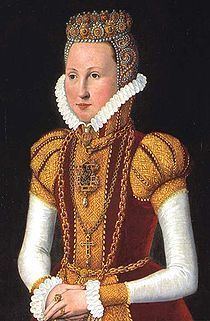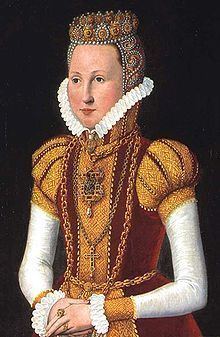Tenure 1572–1588 Role Queen of Denmark Religion Lutheranism | ||
 | ||
Issue Elizabeth, Duchess of BrunswickAnne, Queen of EnglandChristian IV of DenmarkUlrich II, Prince-Bishop of SchwerinAugusta, Duchess Holstein-GottorpHedwig, Electress of SaxonyJohn, Prince of Schleswig-Holstein Name Sophie Mecklenburg-Gustrow Children Christian IV of Denmark, Anne of Denmark Parents Ulrich, Duke of Mecklenburg, Elizabeth of Denmark, Duchess of Mecklenburg Similar People Frederick II of Denmark, Christian IV of Denmark, Elizabeth of Denmark, Anne Catherine of Brande, Frederick I of Denmark | ||
Sophie of Mecklenburg-Güstrow (4 September 1557, Wismar – 14 October 1631, Nykøbing Falster) was a German noble and Queen of Denmark and Norway. She was the mother of King Christian IV of Denmark. She was Regent of Schleswig-Holstein 1590–94.
Contents
Early life
She was the daughter of Duke Ulrich III of Mecklenburg-Güstrow and Princess Elizabeth of Denmark (a daughter of Frederick I and Sophie of Pomerania). Through her father, a grandson of Elizabeth of Oldenburg, she descended from King John of Denmark. Like Ulrich, she had a great love of knowledge. Later, she would be known as one of the most learned Queens of the time.
Marriage and children
At the age of fourteen Sophie, on July 20, 1572, married Frederick II of Denmark in Copenhagen; he was thirty-seven. They were first half-cousins, through their grandfather, Frederick I, King of Denmark and Norway. The marriage was arranged by the Danish Council, who wished the King to marry. King Frederick married her after being barred from marrying his mistress Anne of Hardenberg, the daughter of the Lord Chancellor.

Despite the age difference between Sophie and Frederick, the marriage was described as harmonious. Queen Sophie was a loving mother, nursing her children personally during their illnesses. Because her spouse was well known for vast meals, heavy drinking, and restless behavior which included unfaithfulness, she sent her three eldest children to live with her parents in Güstrow for their early years. She showed a keen interest in science and visited the astronomer Tycho Brahe. She was also interested in the old songs of folklore.
She proved a diligent matchmaker. Her daughter, Anne of Denmark, would marry James VI of Scotland and become queen consort in 1589. She arranged the marriage against the will of the Council.
Sophie and Frederick II had eight children, seven of whom lived to adulthood:
- Elizabeth (25 August 1573 – 19 June 1626), married in 1590 to Henry Julius, Duke of Brunswick-Lüneburg.
- Anne (12 December 1574 – 2 March 1619), married on 23 November 1589 to King James VI of Scotland (later James I of England)
- Christian IV of Denmark and Norway (12 April 1577 – 28 February 1648)
- Ulrik (30 December 1578 – 27 March 1624 in Rühn), last Bishop of the old Schleswig see (1602–1624), and as Ulrich II Lutheran Administrator of the Prince-Bishopric of Schwerin (1603–1624), married with Lady Catherine Hahn-Hinrichshagen
- John August (1579–1579), died in infancy
- Augusta (8 April 1580 – 5 February 1639), married on 30 August 1596 to Duke Johann Adolf of Holstein-Gottorp
- Hedwig (5 August 1581 – 26 November 1641), married on 12 September 1602 to Christian II, Elector of Saxony
- John, Prince of Schleswig-Holstein (9 July 1583 – 28 October 1602)
Regency and later life
Queen Sophie had no political power during the lifetime of her spouse. When her underage son Christian IV became King in 1588, she was given no place in the Regency Council in Denmark itself. From 1590, however, she acted as Regent for the Duchies of Schleswig-Holstein for her son.
She organised a grand funeral for her spouse, arranged for the dowries for her daughters and for her own allowance, all independently and against the will of the Council. She engaged in a power struggle with the Regents of Denmark and with the Council of State, which had Christian declared of age in 1593. She wished the duchies to be divided between her younger sons, which caused a conflict. Sophie only gave up her position the following year, 1594. As such, she came into conflict with the government, which exiled her to the Palace of Nykøbing Slot on the island of Falster. She spent her time there in the study of chemistry, astronomy and other sciences. She also renovated Nykøbing Slot.
The Dowager Queen Sophie managed her estates in Lolland-Falster so well that her son could borrow money from her on several occasions for his wars. She also engaged in large-scale trade and in money-lending. She often visited Mecklenburg, and attended her daughter's wedding in Dresden in 1602. In 1603 she became involved in an inheritance dispute with her uncle, which remained unsolved at his death in 1610. In 1608, she managed to soften the punishment of Rigborg Brockenhuus, and in 1628, she was one of the influential people who prevented her son from having her grandson's lover, Anne Lykke, accused of witchcraft. Sophie died as the richest woman in Northern Europe at the age of seventy-four.
